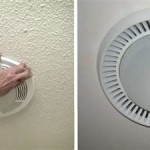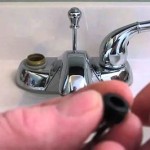Bathroom Sink Faucet Won't Turn On: A Comprehensive Troubleshooting Guide
A bathroom sink faucet that refuses to dispense water is a common household problem that can range from a minor inconvenience to a major disruption. Understanding the potential causes and possessing the knowledge to troubleshoot the issue systematically is crucial for homeowners. This article provides a detailed guide to diagnosing and resolving a non-functioning bathroom sink faucet.
Before embarking on any troubleshooting steps, it is imperative to ensure the problem is localized to the bathroom sink faucet and not a broader plumbing issue. Checking other faucets and water-using appliances in the house, such as toilets and showers, will quickly determine if the problem is isolated. If multiple fixtures are not functioning, the issue likely resides within the main water supply or the plumbing system itself, requiring the expertise of a qualified plumber.
Identifying and Addressing Common Causes
Several factors can contribute to a bathroom sink faucet's failure to turn on. These factors can be categorized into issues related to water supply, faucet components, and external factors such as sediment buildup.
1. Water Supply Issues:
The most fundamental reason a faucet might not work is a disruption in the water supply. This can manifest in several ways. First, the main water valve for the house might be inadvertently shut off. This valve is typically located near the water meter or where the main water line enters the property. Ensuring this valve is fully open is a primary step. Similarly, individual shut-off valves are located under the sink and connect to the hot and cold water supply lines leading to the faucet. These valves may have been partially or completely closed, perhaps during previous plumbing work or by accident. Visually inspecting these valves to confirm they are fully open and aligned with the water supply lines is essential.
In some instances, a water provider might be experiencing a temporary service interruption due to maintenance or a water main break. Contacting the local water authority can provide clarification on whether a widespread outage is affecting the area.
Frozen pipes can also impede water flow, especially in colder climates. If the pipes leading to the faucet are located in an unheated area, such as an exterior wall, they may have frozen. Thawing the pipes gently with a hairdryer or heat tape can restore water flow. Avoid using an open flame, as this poses a significant fire hazard and can damage the pipes.
2. Faucet Component Malfunctions:
If the water supply is confirmed to be functioning correctly, the next step involves examining the faucet's internal components. Faucets are composed of several key parts, including the handle, cartridge (or stem), aerator, and supply lines. Failure in any of these parts can prevent water from flowing.
The cartridge, or stem, controls the flow of water through the faucet. Over time, these components can become clogged with mineral deposits, corroded, or damaged. If the handle moves freely but no water comes out, a faulty cartridge is a likely culprit. Replacing the cartridge typically involves removing the handle, accessing the cartridge, and installing a new one. It is crucial to identify the correct cartridge type for the specific faucet model to ensure compatibility.
The aerator, located at the tip of the faucet, mixes air with the water stream to create a smoother flow and conserve water. However, aerators can accumulate sediment and mineral deposits over time, restricting water flow. Unscrewing the aerator and cleaning it thoroughly with a brush and vinegar solution can often resolve this issue. If the aerator is severely clogged or damaged, replacing it is a simple and inexpensive solution.
The supply lines connect the faucet to the shut-off valves under the sink. These lines can become kinked, twisted, or clogged, restricting water flow. Inspecting the supply lines for any visible damage or obstructions is crucial. If a supply line is kinked, straightening it might restore water flow. If the line is clogged, disconnecting it and flushing it with water can remove any debris. In some cases, replacing the supply line might be necessary.
3. Sediment Buildup and Other External Factors:
Sediment and mineral deposits are common causes of faucet problems, especially in areas with hard water. These deposits can accumulate in various parts of the faucet, including the cartridge, aerator, and supply lines.
Flushing the faucet and supply lines can help remove loose sediment. This involves disconnecting the supply lines from the faucet, placing a bucket underneath the faucet, and briefly opening the shut-off valves to allow water to flush out any debris. Similarly, flushing the supply lines themselves by disconnecting them from the shut-off valves and running water through them can clear any obstructions.
Pressure imbalances within the plumbing system can occasionally affect faucet performance. This can occur if there is a sudden drop in water pressure or if there are issues with the pressure regulator. Checking the water pressure throughout the house can help identify a pressure imbalance problem. A pressure regulator, typically located near the main water valve, ensures consistent water pressure. If the pressure regulator is malfunctioning, it may need to be adjusted or replaced.
In rare cases, debris from plumbing repairs or construction work can enter the water lines and clog the faucet. If recent plumbing work has been performed, this possibility should be considered. Flushing the entire plumbing system might be necessary to remove the debris.
Step-by-Step Troubleshooting Process
Approaching the troubleshooting process systematically is crucial to efficiently identify and resolve the issue. The following steps provide a structured approach:
Step 1: Verify the Water Supply: Begin by confirming that the main water valve and the shut-off valves under the sink are fully open. Check other faucets in the house to ensure the problem is isolated. Contact the local water authority to inquire about any service interruptions.
Step 2: Inspect the Aerator: Unscrew the aerator and clean it thoroughly. Reinstall the aerator and check if the faucet now dispenses water.
Step 3: Examine the Supply Lines: Inspect the supply lines for kinks, twists, or damage. Disconnect the supply lines and flush them with water to remove any debris. Replace the supply lines if necessary.
Step 4: Replace the Cartridge: If the previous steps do not resolve the issue, suspect a faulty cartridge. Identify the correct cartridge type for the faucet model and replace it according to the manufacturer's instructions.
Step 5: Check for Sediment Buildup: Flush the faucet and supply lines to remove any loose sediment. Consider flushing the entire plumbing system if necessary.
Step 6: Evaluate Water Pressure: Check the water pressure throughout the house. If there is a significant drop in pressure, investigate the pressure regulator or other potential pressure-related issues.
Tools and Materials
Having the right tools and materials on hand can streamline the troubleshooting process. Essential tools include an adjustable wrench, pliers, screwdrivers (both flathead and Phillips head), a bucket, towels, and a flashlight. Materials might include replacement cartridges, aerators, supply lines, Teflon tape, and a penetrating oil lubricant.
Prior to commencing any repairs, it is vital to shut off the water supply to the faucet by closing the shut-off valves under the sink. This will prevent water from flowing during the repair process and minimize the risk of water damage.
When disassembling faucet components, it is advisable to take photographs of each step. This will serve as a visual reference during reassembly and ensure that all parts are correctly positioned.
Applying Teflon tape to threaded connections can help prevent leaks. Wrap the Teflon tape clockwise around the threads, overlapping each layer slightly.
If a faucet is difficult to disassemble due to corrosion or mineral buildup, applying a penetrating oil lubricant can help loosen the parts. Allow the lubricant to soak for several minutes before attempting to disassemble the faucet.
Safety precautions are paramount when working with plumbing. Wear safety glasses to protect the eyes from debris and gloves to protect the hands from sharp edges or chemicals.

Check Plumbing Problem No Tap Water Coming Out Of Your Faucet Rowin

How To Fix A Hard Turn Bathroom Faucet Handle

Bathroom Handle Stiff Or Difficult To Operate

Bathroom Sink Faucet Won T Stop Running Doityourself Com Community Forums

How To Fix A Hard Turn Faucet Handle So Easy The Frugal Girls

No Water Coming Out Of The Tap How To Fix 10 Tips

Lav Faucet Hot Side Handle Stuck

How To Change The Handle Rotation On A Faucet

My Kitchen Faucet Won T Turn Off

How To Tighten Faucet Handle Homeserve Usa
Related Posts







